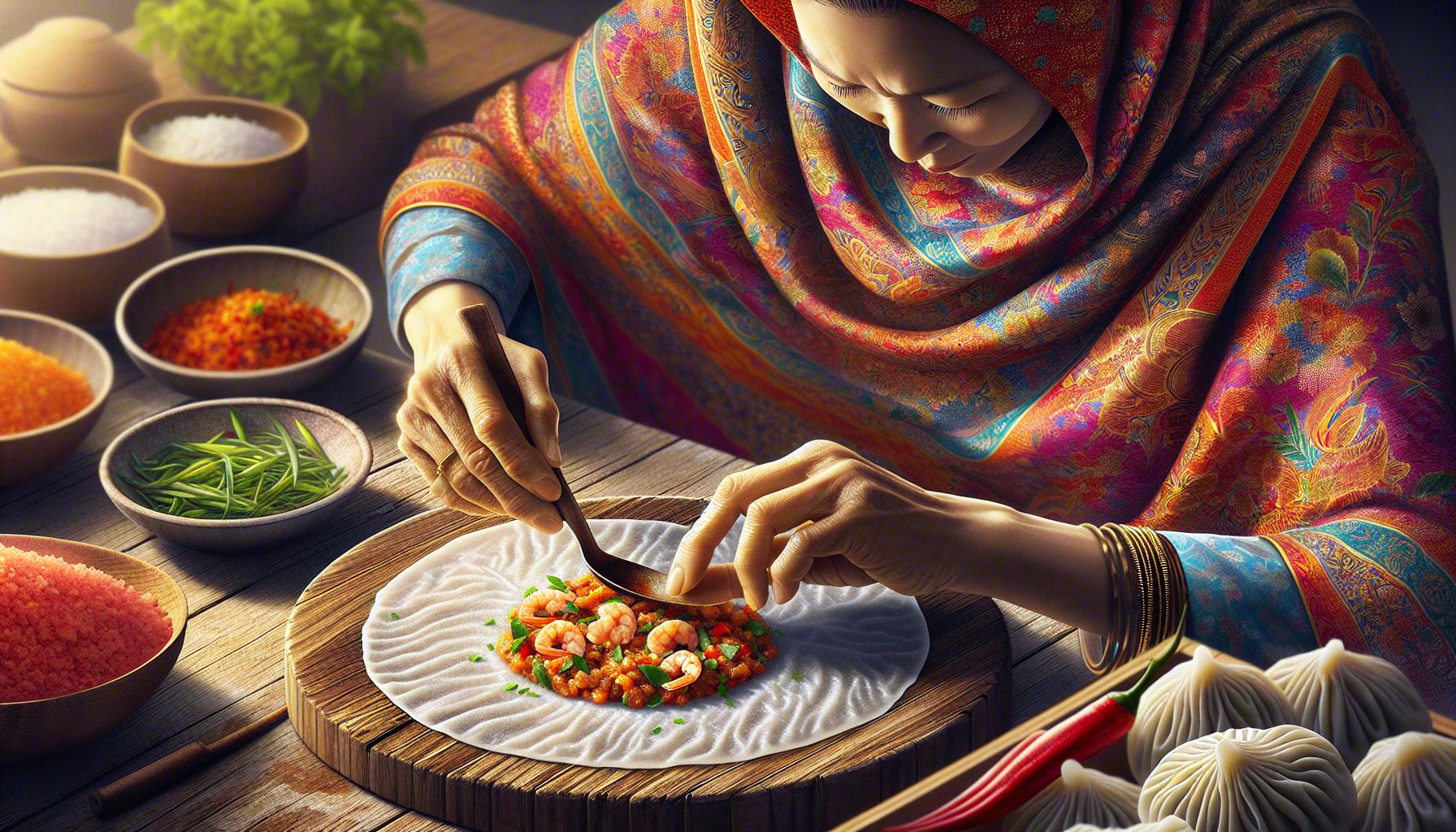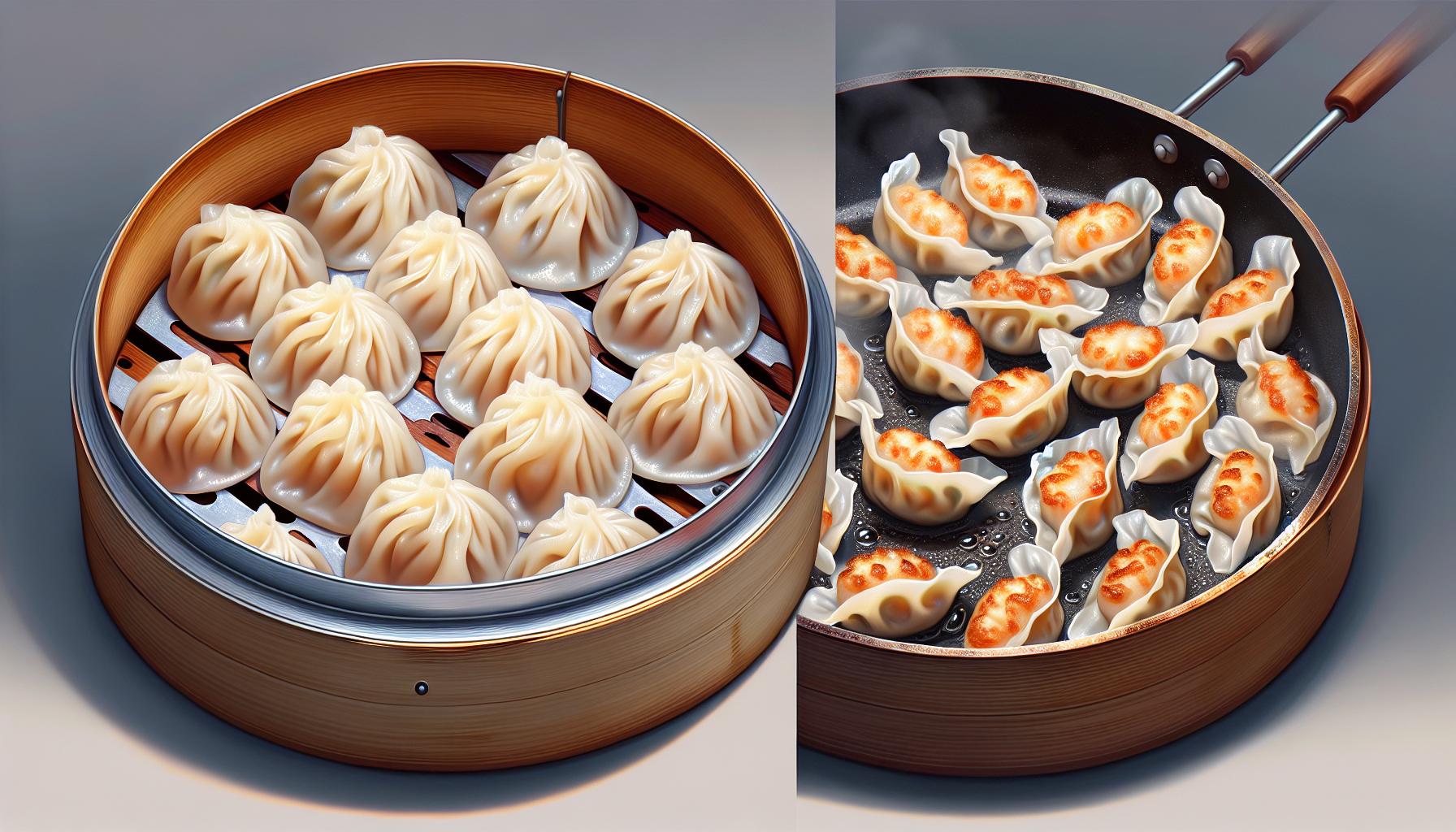Ingredients for Homemade Saewu Mandu Shrimp Dumplings
Embark on this culinary journey to the heart of Korea using simple, yet rich ingredients. Here’s the list you’ll need to whip up your homemade Saewu Mandu – a feast surely to impress.
First off, for the dumplings, gather the following:
- 18oz raw shrimp, peeled, deveined
- 3 green onions, finely chopped
- 1 large egg
- 1 tbsp soy sauce
- 1 tsp sesame oil
- Salt and pepper, to taste
- 30 dumpling wrappers
Your Saewu Mandu wouldn’t be complete without the dipping sauce. Here’s what you’ll need:
- 4 tbsp soy sauce
- 1 tbsp vinegar
- 1/2 tsp sesame oil
- Pinch of crushed red pepper flakes
Feel free to tweak the quantities to suit your palette. For example, you might want to add a teaspoon of chopped fresh ginger to the dumpling filling for an extra zing. Or, sprinkle a few sesame seeds over the dipping sauce to amplify its nutty profile.
The best part about creating your own Saewu Mandu? Personalizing it. You’re the chef! Get creative and make this dish uniquely yours.
Take note of the nutrition facts per serving, too:
| Nutrient | Amount |
|---|---|
| Calories | 212 |
| Carbohydrates | 24.4g |
| Protein | 13.9g |
| Fat | 5.9g |
Step-by-Step Instructions

Firstly, it’s all about chopping your shrimp to a medium-fine texture. Tip: Keep your fresh shrimp chilled until you’re ready to mince them – it makes the job that much easier. Next, mix together your shrimp with your spices – garlic and chives blend well, but don’t be afraid to add your own kick. Experimentation with herbs and seasonings can lead to a unique flavor profile that makes your dish memorable!
Measure out your dumpling skins. We’re aiming for circles around 3.5 inches in diameter. Fill each skin with a generous spoonful of your shrimp mix. Then seal those dumplings tight. Remember, you don’t want any of that delicious filling to escape.
Here’s where personal preference factors in – your cooking method. You can steam these beauties or go for a quick pan-fry for a crispier exterior. Either way, you’ll unleash mouth-watering aromas indicative of the culinary delight yet to come.
While your dumplings are cooking, mix up the dipping sauce. This sauce – a blend of soy sauce, vinegar, and sesame oil – is the perfect compliment to your homemade mandu shrimp dumplings. Drizzle lightly, or dip freely, it’s your call.
No matter what cooking or seasoning path you choose, this recipe provides ample opportunity for culinary creativity. However you choose to craft your saewu mandu, the result promises to be nothing short of delicious. As always, enjoy the adventure of cooking, discovering flavors and tastes, and most importantly, savoring your homemade dish.
As a side note, in each serving of this delectable dish, you’ll be consuming 212 calories, consisting of 24.4g of carbohydrates, 13.9g of protein, and merely 5.9g of fat. Not a bad score for such a gastronomical delight, is it?
Overall, the saewu mandu shrimp dumplings contain:
| Nutrient | Amount |
|---|---|
| Calories | 212 |
| Carbohydrates | 24.4g |
| Proteins | 13.9g |
| Fats | 5.9g |
Tips for Wrapping the Dumplings

Now that we’ve mastered the filling, let’s tackle the art of dumpling wrapping. This is where precision comes to play, adding both aesthetic and functional values to your mandu.
The first rule is ‘less is more’. Overstuffing may seem tempting, but too much filling may cause your dumplings to burst open during cooking. Aim for about a teaspoon of filling for each dumpling.
Before you seal your dumplings, ensure that the edges of the wrapper are moist. Applying a thin layer of water on the edges of the dumpling skin forms a seal, stopping the filling from spilling out. You can use your fingers or a small pastry brush to do this.
Which brings us to a crux point, the wrapping techniques. There are multiple ways to wrap your dumplings, from simple half-moons to pleated crescents or sealed pouches. Let’s explore a couple.
The Half-Moon: After placing the filling on one side, fold the dumpling wrapper over to form a half-moon shape. Press the edges together to seal. It’s straightforward, simple, and great for beginners.
The Pleated Crescent: For a fancier look, after folding into a half-moon, create pleats along the edge by folding small sections of the wrapper inwards and pressing. This may take a bit of practice, but the results are worth it.
And last but in no means least, it’s crucial to ensure the dumplings are prepared uniformly to promote even cooking. It’s about consistency in size, shape, and sealing.
Wrapping dumplings could well be considered a meticulous craft, but with practice and patience, it won’t feel daunting. Soon, you’ll be wrapping like a pro, turning out impeccably sealed mandu, ready for their steamy transformation. The flavorsome results will be a testament to your culinary dexterity.
Let’s venture forth into cooking methods. Whether you’re up for a healthful steamed variant or eyeing a pan-fried crunch, we have both avenues laid out for you in the upcoming sections. So, stay tuned as we dive deeper into your homemade saewu mandu shrimp dumplings.
Cooking the Shrimp Dumplings

Now that you’ve nailed the art of uniformly filling and folding your dumplings, it’s time to cook these tiny parcels of flavour. You can either steam or pan-fry your saewu mandu. Each method lends its unique texture and taste to the dumplings, transforming them into delectable morsels.
Steaming the Dumplings
Steaming is a gentler method, preserving the delicate flavours and texture of the shrimp. Fill your steamer with water, just enough to avoid touching the base of the steamer basket. Bring the water to a boil and then place the dumplings in the basket, keeping enough distance between each to prevent sticking.
Steam for about 12 – 15 minutes or until the dumpling wrappers become translucent. It’s important not to oversteam as the wrappers may turn gummy and lose their texture.
Pan-Frying the Dumplings
If you’ve a fondness for a crispy texture, pan-frying is your route. Heat a non-stick pan with a sufficient amount of oil. Add your dumplings, flat side down, leaving space between each. Fry on medium heat until the bottoms turn a golden-brown.
Next, add a little water to the pan and cover it to create steam. Remember, it’s the combination of frying and steaming that gives the dumplings their hallmark crispy-bottom, soft-top texture. Cook until the water evaporates; usually, this takes 8 – 10 minutes.
The stage is all set for you to try these cooking methods. Remember, like all culinary skills, it takes time and practice to master the art of cooking these dumplings. But rest assured, your patience and labour of love will bear delicious dividends.
As we continue our delve into the world of shrimp dumplings, stay tuned for the next section where we’ll be discussing great dip recipes to accompany your homemade saewu mandu.
Serving and Enjoying the Dish

Now that you’ve successfully cooked up your scrumptious Saewu Mandu, how to serve it up and enjoy it is what we’ll explore next. Here lies the final, yet important part of your culinary journey – setting the table, and savoring the delectable shrimp dumplings at their best.
Setting the Table
First things first, lay your meal on a traditional wooden Mandu plate. Not only does this plate emphasize the aesthetics of your Saewu Mandu, but it also keeps the dumplings fresh and crunchy. Size the portions based on hunger levels – a usual serving constitutes around six to eight pieces of Mandu.
Offer Some Zing
While these shrimp dumplings taste divine on their own, pairing them with a sauce elevates their flavor profile. Try sauces like spicy Gochujang, a classic soy-vinegar dip, or even a homemade secret sauce using your favorite ingredients. Playing with flavors, after all, is an enjoyable part of cooking!
Let’s Chow Down
The perfect way to enjoy these dumplings is fresh off the pan or steamer, when they’re still warm and their rich shrimp filling is at its most flavorful. But remember, Saewu Mandu are more than a meal, they are a cultural experience. Each bite just can’t be rushed – take your time, savor each dumpling, its textures, its flavors, and relish the satisfaction that you prepared them yourself.
Of course, the pleasure of food multiplies when shared. So go ahead, invite your loved ones and transform this cooking and eating endeavor into a social event. Laughter, conversation, and a feast on your homemade Saewu Mandu – it’s bound to be a memorable affair.
Conclusion
You’ve journeyed through the art of making homemade saewu mandu shrimp dumplings. You’ve learned not just a recipe, but a cultural experience. Now it’s your turn to bring this culinary delight to life. Remember, the magic lies in the details – the wrapping techniques, the traditional wooden Mandu plate, and the pairing with Gochujang or soy-vinegar dip. Savor each bite, relish in the textures and flavors, and most importantly, share this joy with your loved ones. The satisfaction of preparing and enjoying these dumplings is a social event in itself. So, go ahead, fill your kitchen with the aroma of saewu mandu and your home with laughter and conversation.

